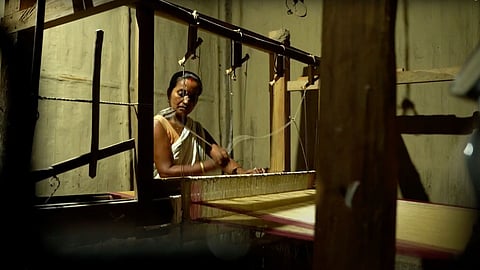
- HOMEGROWN WORLD
- #HGCREATORS
- #HGEXPLORE
- #HGVOICES
- #HGSHOP
- CAREERS
- ABOUT US
- CONTACT US

In August 2024, I was working with WWF-India West Arunachal Landscape to document the cultural heritage of the Monpa tribe in West Kameng's Chug Valley. It was my first trip to Arunachal, and I was shocked by how little I knew about the rich history and cultural heritage of the Mon people — the largest Tibetan Buddhist tribe in the sunrise state. During my month-long stay with a Monpa family at the Malayama village, I learned so much about the indigenous knowledge systems of the Monpa tribe — from their traditional Mon-Shugu paper-making craft to their sheep's wool and Eri silk hand-dyed, hand-woven, and hand-embroidered textile tradition. I also learned how little I knew about the Monpa, and the rest of Northeast India.
For most of India's modern history, the northeastern states — nestled in the vast wilderness of the eastern Himalayas — have been relegated to the margins of the Indian mainstream. Once independent kingdoms ruled by the region's indigenous tribes and communities, these territories came to be a part of India during the British Raj. But even after 78 years of Independence, Indian mainlanders have little awareness of the rich, varied natural and cultural heritage of Northeast India.
Although they are often clubbed together as the 'Seven Sisters', Assam, Arunachal Pradesh, Meghalaya, Mizoram, Tripura, and Nagaland — the seven states (eight including Sikkim) that make up India's remote northeastern frontier — each have distinct and unique histories, heritage, and culture. 'Stories From The Ground: Northeast India', a series of 50 documentary shorts supported by The Habitats Trust and Dusty Foot Productions, featuring local filmmakers from the region celebrate the distinct and diverse culture, traditions, and biodiversity of the region.
The core idea behind the series is to focus on local stories in local languages (although with English subtitles for accessibility) which cover untold stories from the region — especially that look at the importance of protecting the region's climate-sensitive habitats and ecologies.
La Lan King's 'The Last Honey-Hunters', for example, documents the story of Penthong, of the Khiamniungan tribe, from Wui village in Nagaland who believes in a different kind of adventure sport — climbing cliffs to hunt for honey. But this is a tradition that doesn't have many followers left, and he may soon be the last of the honey hunters.
Similarly, filmmaker Seela Lepcha's 'Indigenous Seed Keeper', tells the story of Chewang Lepcha from Sikkim's Gnon-Sangdong village, who has been safe-keeping the seeds of millet and buckwheat — the traditional food grains of the Lepcha — to preserve the indigenous food traditions of the community.
There are many more such stories in the series: Tallo Anthony's ‘Chhoskhorrong Kho: The Saviour of Aquatic Life’ introduces viewers to a community group called Garung Thuk ("Our Village") in the West Kameng District of Arunachal Pradesh. The group has adopted a section of the rainfed Chhoskhorrong Kho river that flows through the region and initiated a long-term conservation effort to help safeguard the region's floristic diversity and increase the fish population in the river; and Sara Khongsai's 'The Lost Identity of Ollo' tells the story of the Ollo tribe of Lazu village in the Tirap district. The Ollo are known for their unique facial tattoos, especially among women. But as modernisation progresses, the younger generation moving away from it, and this age-old practice is slowly fading away. Today, the Ollo of Lazu are the last tribe in the district to maintain this distinctive and revered tradition.
These 50 documentary short films, told in 22 local languages and dialects, include topics around conservation, habitats, wildlife, indigenous knowledge, agro-biodiversity, scientific research as well as threats and solutions; they cover 28 districts across the 8 states of Northeast India; and still represent only the surface of Northeast India's vast wealth of human and natural history and heritage.
Watch the complete series here.
If you enjoyed reading this, here's more from Homegrown:
Short Films From The Northeast On Gender, Identity & Acceptance
4 Compelling & Powerful Short Films From The Northeast
From Akhuni To Amrusu: 9 Iconic Dishes From Nagaland You Should Try
